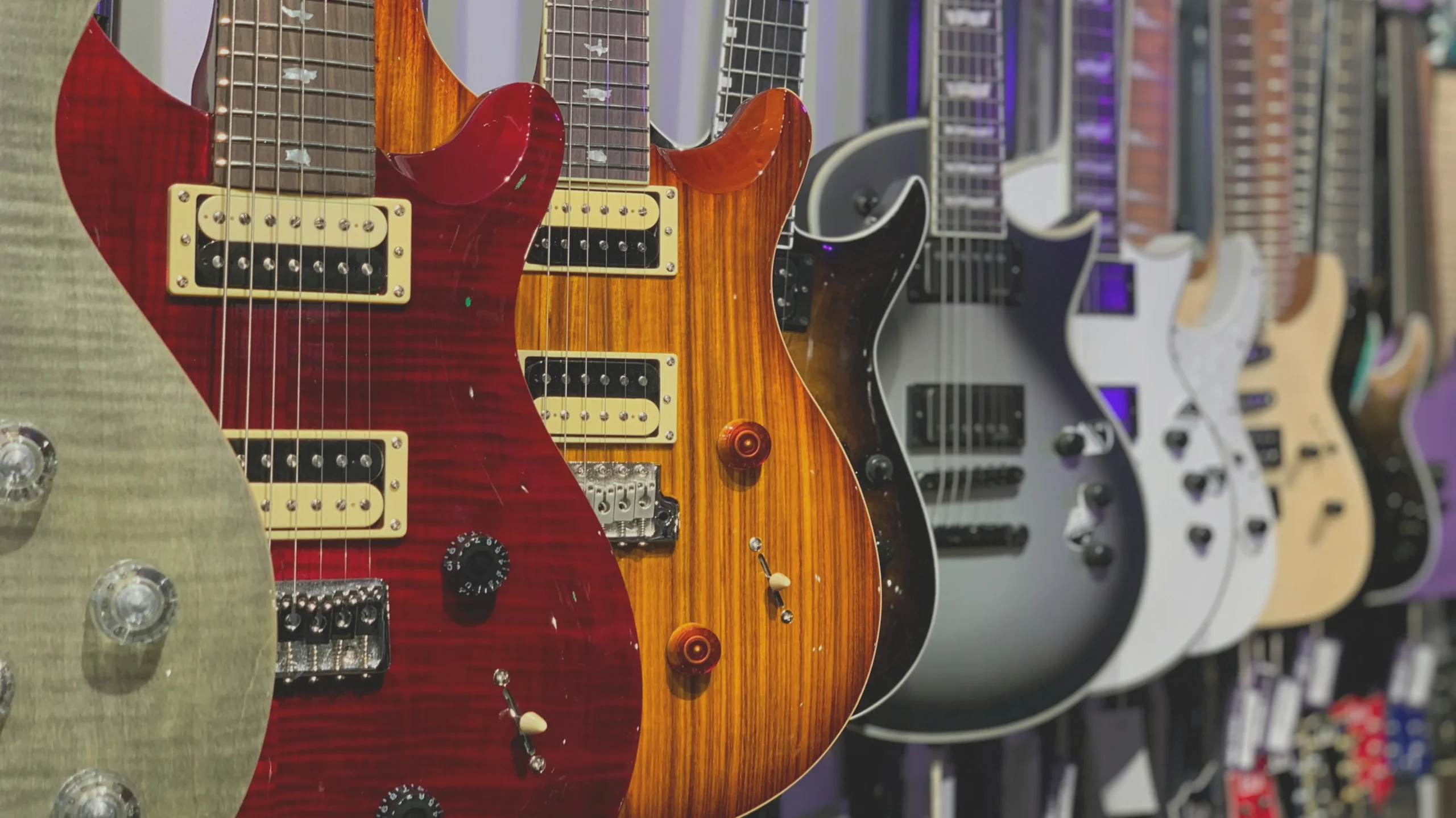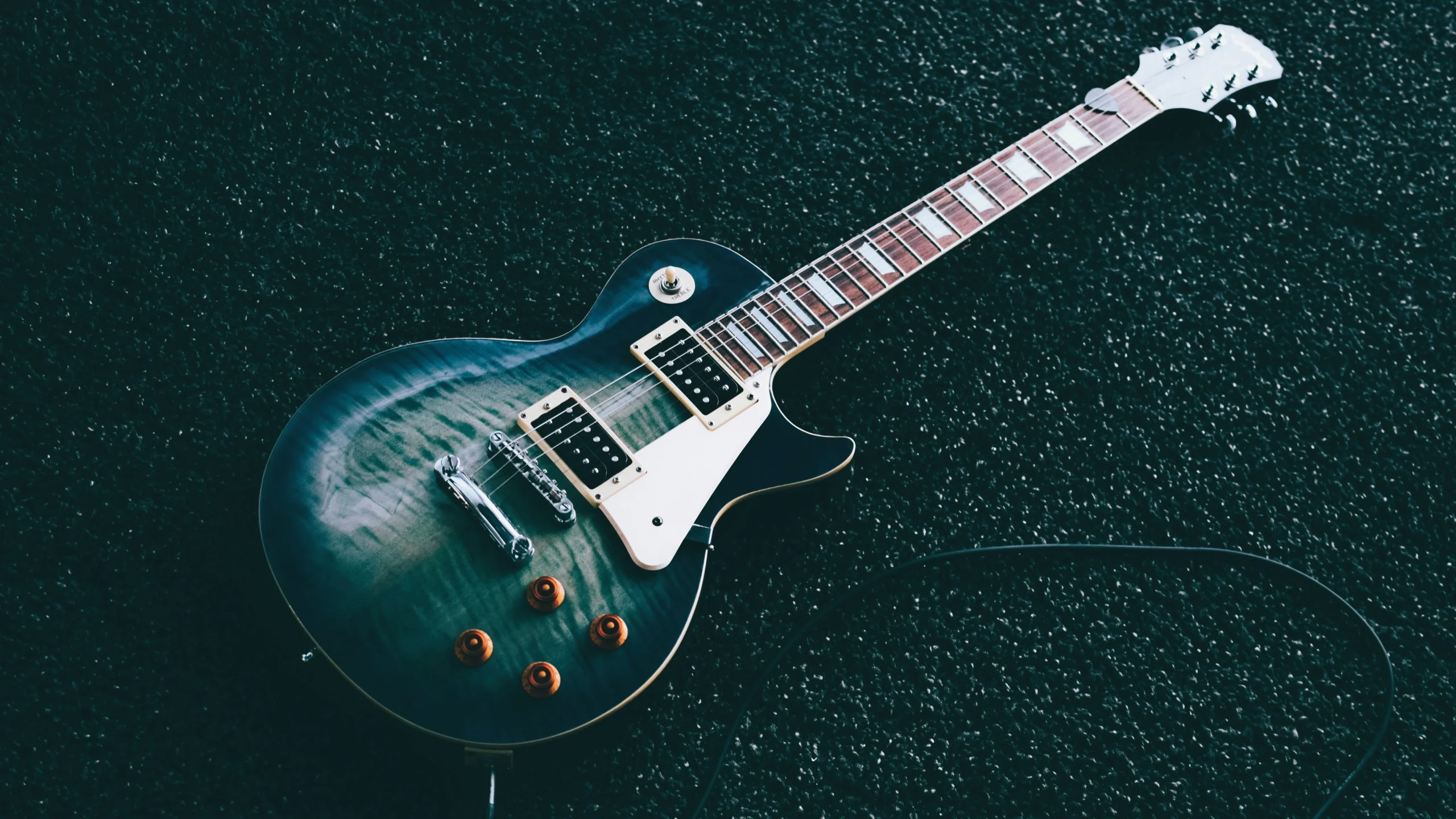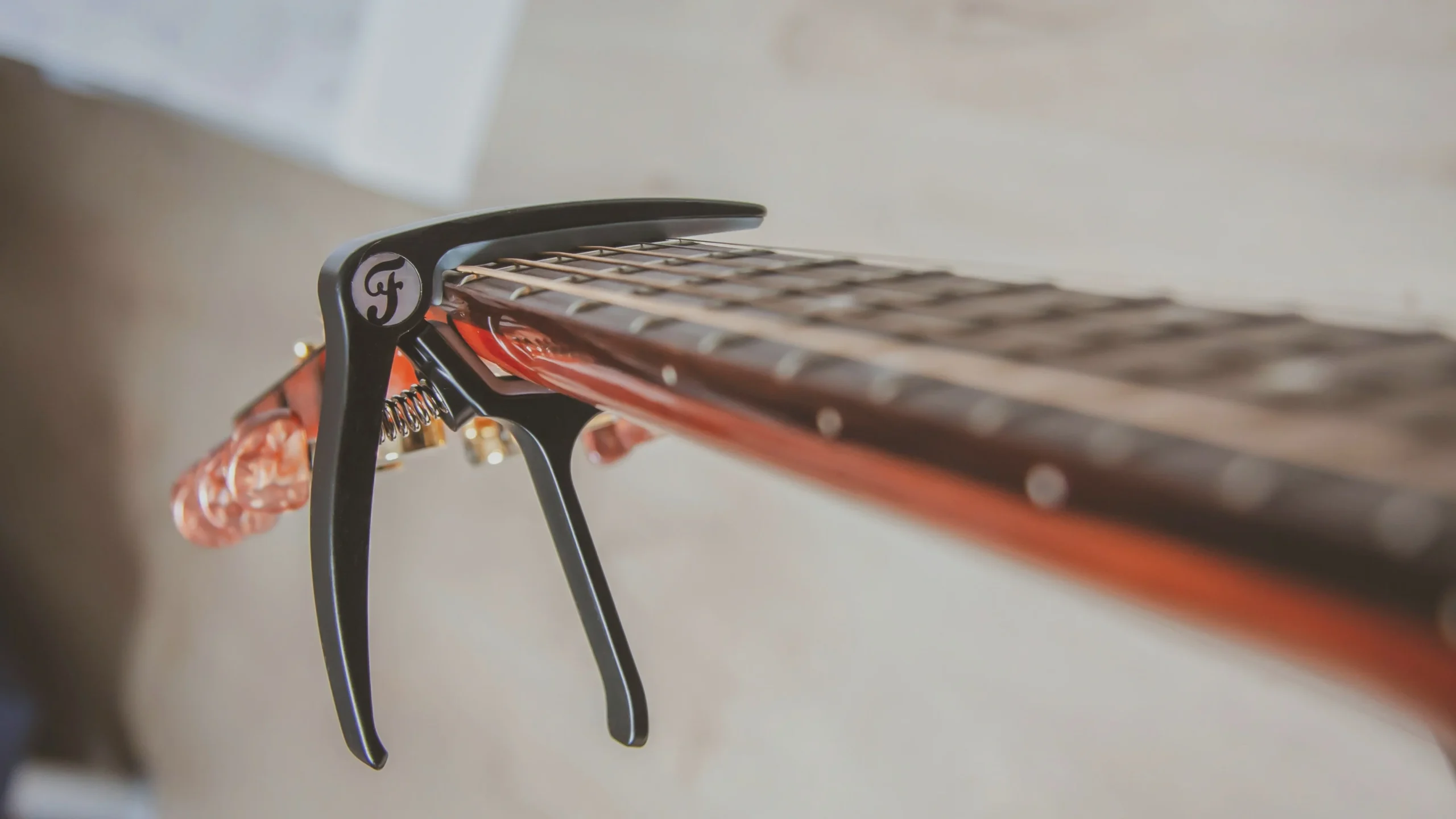
How Big Is A Full Size Electric Guitar?
If you’re in the market for a new electric guitar, you may be wondering just how big a full-size electric guitar actually is.
Here, I will explore the dimensions of a full-size electric guitar and provide some context to help you make an informed decision.
I’ll discuss the typical length, width, and depth of a full-size electric guitar, as well as any variations or factors that can affect its size.
No matter what level you are at when it comes to playing an electric guitar or what size you need, this article will provide the information you need.
So, let’s dive into the world of electric guitars and discover just how big they really are!
Table of Contents
How Do I Measure The Size Of A Guitar?
There are several ways to figure out what size guitar someone has. These are the most popular ones.
Total Length
The entire length of the guitar is the distance from the top of the headstock to the end of the body.
Because guitars can have different headstocks and body forms, this is not always the most reliable method of measuring them.
When purchasing accessories such as a guitar case, you usually need the whole length of the guitar to ensure that it fits snuggly.
Scale Length
Scale length refers to the distance between a guitar’s nut and bridge.
You can also measure and double the distance between the nut and the 12th fret. This will also show you the scale length.
The typical size for a ‘full-length’ electric guitar is 25.5 inches, whereas basses are 34 inches. The scale length of a guitar frequently impacts its playability.
Neck Width
One more way to figure out what size guitar it is is to look at how wide the neck is.
Like lengths, most guitars have a standard neck, but some guitar players like a thicker or thinner neck based on how they play and what feels best to them.
The Fender Stratocaster has a neck width of 1.65 inches, but the Gibson Les Paul has a neck width of 1.9 inches.
A thin neck is better for you if you play rhythm guitar than a thin neck. If you play by yourself, a larger neck will help you.
How Big Is A Full-Size Electric Guitar?
There may not be as many sizes of electric guitars as there are of acoustic guitars, but the length of the whole thing changes depending on the body type.
Short Scale
The scale length on these guitars is shorter. This makes the strain lower and the space between the frets smaller.
This makes it easy to move around the frets, even if your hands are somewhat small. A short-scale guitar can look a lot of different ways.
Travel
There are a lot of brands that make travel electric guitars, but they’re not as popular as the other types.
Most of the time, they have a ¾ scale and light bodies, which makes them smaller than a regular electric guitar.
Guitars with strange bodies, like Steiberger’s “Spirit” or Yamaha’s “Silent” SLG200S, are more of a surprise. They are easy to carry around with you.
When it comes to sound, Travel guitars don’t always sound as good as Junior or Short-Scale guitars.
Junior
If your kids want to learn how to play the guitar, a junior guitar like the Ibanez “Mikro” or the Squier Mini Jazzmaster might be perfect for them, but adults can also find them useful.
The frets on these guitars are shorter, the bodies are smaller, and they are often short-scale.
Full-sized electric guitars are often hard for kids to play because they are so big and heavy, which is one reason why these guitars are so popular.
A Gibson Les Paul Junior weighs about 7 pounds, but a full-sized Les Paul can weigh up to 9 to 12 pounds. The junior guitar is not only smaller, but it is also a lot lighter to hold.
Solid Body
A lot of guitars, like the Gibson Les Paul and the Fender Stratocaster and Telecaster, have flat bodies.
These usually have a 25-inch scale and are 38 inches long all together. In general, bass guitars have 34-inch scale lengths.
There are some differences in the shape and width of the neck, but these are the most common guitar sizes.
You can pick from many different kinds of solid-body guitars.
When someone buys a guitar, they think about how they want it to sound and what kind of music they want to play. You can play rhythm, lead, or both with them.
Hollow Body
These are different from solid-body guitars because the bodies are cut away.
They are also called “Thinline” or “Semi Acoustic” guitars. In general, their scale length is average, but they are lighter than Jumbo or Dreadnought guitars.
Because they have a lot of gain, these guitars sound best in jazz and blues styles.

Standard Full Size Electric Guitar Dimensions
Full-size electric guitars often have specified proportions, which ensures consistency in their physical characteristics.
The most typical length of a full-size electric guitar is 39 to 41 inches, with a scale length of roughly 25.5 inches.
The scale length refers to the vibrating length of the strings from the nut to the bridge, which has a direct impact on the instrument’s playability and tone.
Furthermore, the body width of a regular full-size electric guitar ranges from 12 to 13.5 inches, allowing plenty of room for comfortable playing and agility.
The body depth varies from 1.5 to 2.75 inches, which affects the guitar’s overall resonance and tone qualities.
Furthermore, the neck width at the nut (where the headstock meets the fretboard) is typically around 1.625 inches, providing a balanced grip for fretting and chord transitions.
A regular full-size electric guitar typically has 21 to 24 frets, providing for a broader range and greater versatility in playing different musical styles.
Furthermore, the weight of a full-size electric guitar ranges between 6 and 12 pounds, depending on the materials used in its manufacture.
This weight range guarantees that the instrument is comfortable to play for long periods while also providing stability and resonance.
Understanding these standard measurements is critical for guitarists looking for a full-size electric guitar that suits their physical needs and playing style.
These dimensions serve as a benchmark for comparing the ergonomics and sound capabilities of various models, allowing players to make an informed decision depending on their unique requirements and playing style.
Understanding the Sizing of a Guitar
The sizes of most instruments are all about the same, and the measurements of each part will match up with the others.
On the other hand, guitars aren’t really like this—they have a lot of different parts and sizes that you need to think about.
The first time I played a prominent acoustic guitar is an excellent example of this.
It said it was a “full-sized” guitar, and I was eleven years old. I didn’t want to buy a smaller guitar because I knew I would get bigger.
But when I finally played it in a music shop, I was shocked by how thick the body was compared to other acoustics I had held.
Since this is the case, you should check the measures of the guitar parts you are thinking about buying. Just because it comes in a specific size shape doesn’t mean it will fit well.
It has three main parts: the body, the neck, and the machine head, which is also called the headstock.
You won’t have to worry about the machine head very much. It’s just the end of the neck, and you’ll only need to use it to tune your guitar. Still, you should measure the body and the neck.
Most of the time, the neck will determine the size of the guitar. Necks on smaller sizes will be shorter, and necks on full-sized guitars will be about the same size all the way around.
This is how most necks are measured: from the bridge (where you strum the strings) to the top of the neck. This is called the scale.
Full-sized guitars usually have a scale that is 25.5 inches long, which makes the guitar 40 inches long altogether.
You can find this scale on most of the significant guitar types, like Stratocasters and Telecasters.
Bodies, on the other hand, are not as simple. There are three sizes to think about here: the width, the depth, and the length from the bottom of the body to the bridge.
The most important thing to measure is depth.
Even if you buy a guitar with the right body size and neck length, it might be hard to reach the bridge with your right hand if the width is too great.
You should go to a music shop like Guitar Center and play some guitars.
If you want to see how they compare, try some chunky giant acoustics like the Takamine GJ72CE-NAT or the Epiphone J-200 and then some thinner electric guitars like the Gibson Les Paul or B-52.
You’ll get a good idea of what will feel good to you after this.
Variations In Full-Size Electric Guitar Sizes
There are normal sizes for full-size electric guitars, but there are also significant differences in sizes to fit different playing styles and player tastes.
One common difference is the body shape, which can be anything from the classic double-cutaway to more unique and comfortable shapes.
These different body shapes not only make the guitar look better but also affect how easy it is to reach higher notes and how comfortable it is to play for long periods.
Scale length is another thing that can be different.
Some full-size electric guitars have shorter scale lengths, usually around 24 inches, which makes playing more accessible and gives the sound a warmer quality.
Extended-range guitars, on the other hand, can have longer scale lengths—up to 27 inches—so they can fit more strings and lower tunings, which is what metal, progressive, and experimental players need.
There are also significant differences in the neck’s width and profile, from thin, fast-playing necks to thicker, heavier profiles.
This gives players with different hand sizes and playing styles a range of physical experiences.
Neck shapes also affect how the guitar feels and how stable it is, as well as how easy it is to fret and bend notes.
There are big differences in body thickness.
Some full-size electric guitars have thinner, contoured bodies for better comfort and less weight, while others have thicker, solid-body constructions for better sustain and sound.
These differences in body thickness help players to pick a guitar that fits their musical style.
Knowing these differences in full-size electric guitar sizes gives players the freedom to try out a lot of different choices that fit their playing style and musical goals.
By looking at these differences, players can find a full-size electric guitar that not only fits their needs for comfort but also fits with their artistic vision, making their playing journey more rewarding in the end.
Factors To Consider When Choosing A Full-Size Electric Guitar
When selecting the appropriate guitar size, you should examine not only the type of guitar you wish to play, as previously discussed but also how it matches your body size and playing style.
For example, if you are small, petite, or have short arms, selecting a guitar with a broader body may be unpleasant. Consider your height, hand size, and other aspects.
Let’s have a look at them all so you know what to look for and consider when trying out different sorts of guitars to find the best fit.
Age
Age should not be the primary consideration when selecting a guitar size, but it would be foolish to overlook it.
If you’re buying a guitar for a youngster, they’ll be smaller than an adult, with smaller hands, fingers, and arms.
A little youngster may require a lower guitar size to reach the frets and play comfortably without straining their arms or hands.
Children under the age of eight should begin with a 1/4 size guitar, while older children and adults can typically begin with a 1/2 or 3/4 size guitar, depending on their height.
Height
Taller people typically have longer arms and larger hands. As a result, they will be able to play a larger guitar with significantly fewer concerns or difficulties.
However, it is not as simple as saying shorter folks require a smaller guitar’.
That’s because the length of the player’s arms and the size of their hands will have a far more significant impact on how easy or difficult it is for them to play the guitar.
Consider this: someone who is tall but has short arms, or small hands may find playing a smaller guitar more comfortable, whereas someone who is shorter but has longer arms and larger hands may prefer the larger guitar.
I’m slightly taller than average and have quite lengthy arms, but my hands are tiny.
So, I don’t have any severe issues with more prominent body guitars, but I do need to consider neck size and form.
Arm Length
As previously stated, your arm length might influence whether or not various guitar sizes are comfortable.
If your arms are shorter, you may find it easier to play a smaller guitar, such as a parlor or concert.
These guitars have smaller bodies, making them more straightforward to reach and play comfortably.
If you have longer arms, you might prefer a larger guitar, like a dreadnought or jumbo.
Having larger bodies, like they have, allows your arms and hands more room to move around while playing.
You should not measure your arms and then look for a guitar that matches your arm’s length. That’d be weird.
However, you probably know if you have shorter or longer arms, which is essential to consider while testing out different guitars.
Your Body
When selecting a guitar, your body size can be an essential consideration. We come in a variety of forms and sizes, including thick and thin, long and short.
Generally, larger-bodied persons will feel more at ease playing a larger guitar, whereas smaller-bodied people may prefer a smaller guitar.
Trying to learn on a small acoustic guitar for a 6ft 5″ man will be difficult and embarrassing.
The apparent physical distinctions between men and women are also worth considering.
However, it is worth noting that if you are a woman or girl, you may have different needs or find that you are not as comfortable with guitars as men are.
Unfortunately, there aren’t many solutions developed with women in mind, though this is changing. It also doesn’t imply that you’ll struggle with ordinary guitars.
Personally, and in terms of bodily size, I’m clearly on the leaner and more minor side of the scale.
So, while I don’t have a problem with arm length, my more petite build makes larger acoustic guitars feel too enormous and overwhelming.
However, like with height, the most essential components in determining the size of a guitar are arm length and hand size.
Playing Style
The size of the guitar should not come before the type of music you want to play. For example, you are a significant fan of rock music and have decided to learn to play the guitar.
So, you’ll need an electric guitar. But you’re concerned that an electric is too large for you.
Instead, you’re going to acquire a classical or tiny acoustic since you believe it will be easier.
That is not going to work. If you can’t play the music styles and genres you enjoy on your guitar, you’re unlikely to learn them.
When I first began out, I realized that if I only had a nylon string classical, I would give up. Why? Because I wanted to play rock music. A classical wouldn’t let me do that.
Final Words
Understanding the size of a full-size electric guitar is essential for both beginners and experienced players alike.
The standard dimensions of a full-size electric guitar typically range from 38 to 42 inches in length, with a scale length of around 25.5 inches.
These measurements ensure that the guitar is comfortable to play and provides the desired sound quality.
It’s worth noting that there can be variations in size and shape among different models and brands, so it’s always recommended to try out different guitars to find the one that feels right for you.
Whether you’re just starting your musical journey or looking to expand your collection, knowing the size of a full-size electric guitar will help you make an informed decision when choosing your following instrument.


